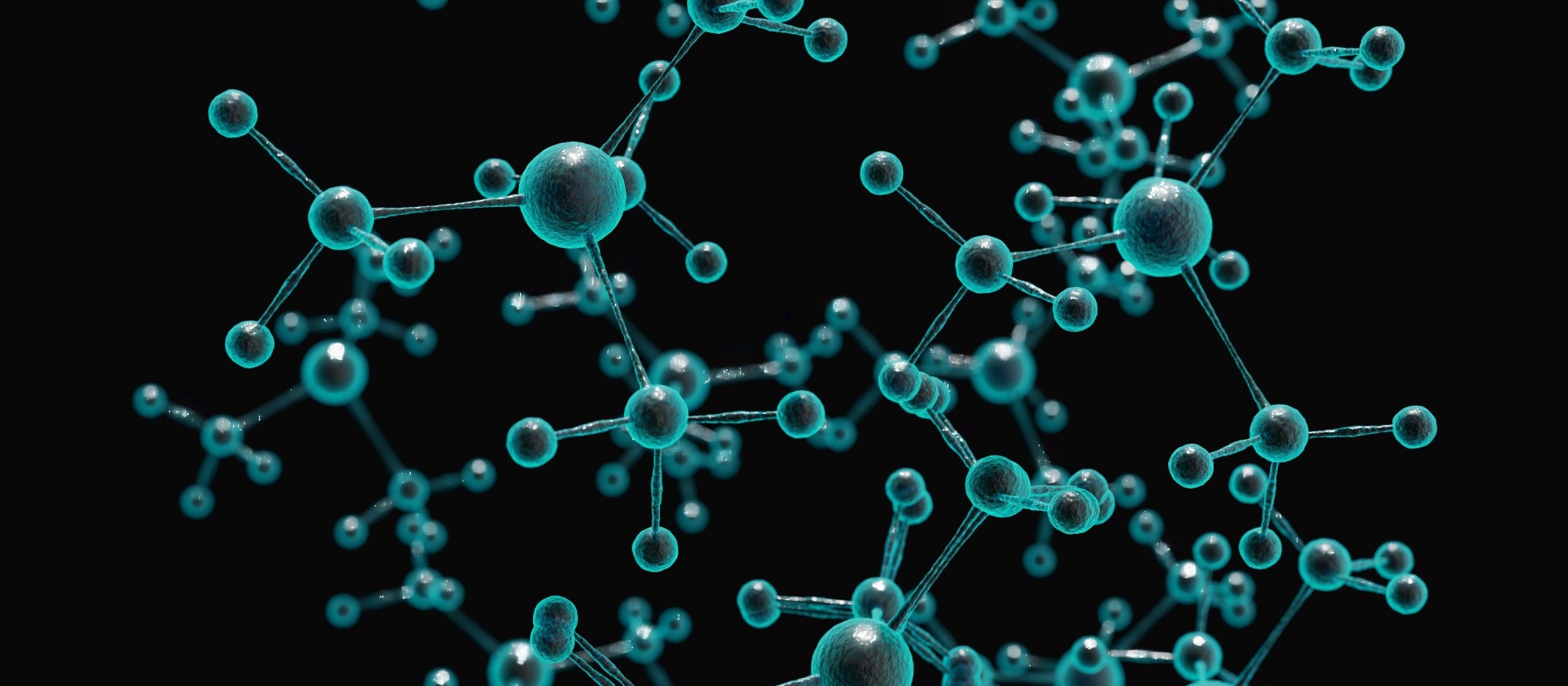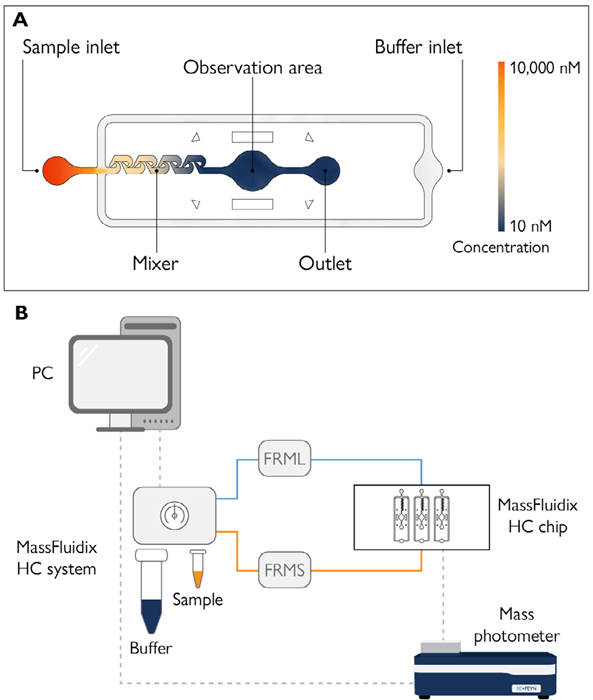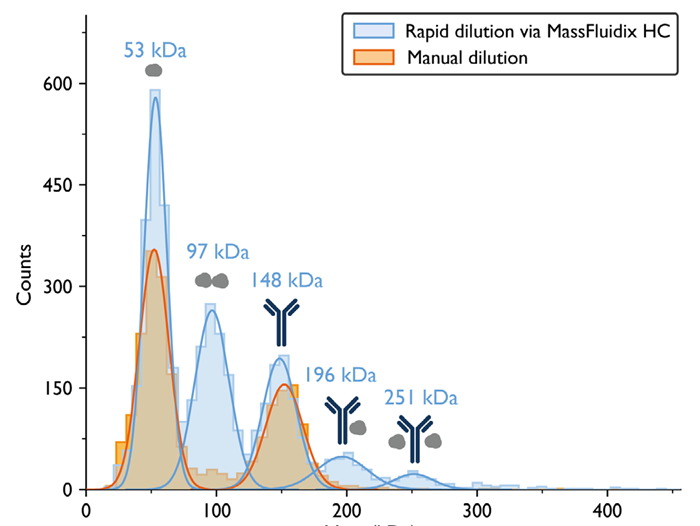Sponsored Content by RefeynReviewed by Olivia FrostJul 17 2024
The analysis of biomolecular interactions is simple and straightforward with mass photometry. This popular and widely used technology allows for the quantitative analysis of binding, oligomerization, and macromolecular assembly, enabling this both in solution and without any requirement for labels.

Image Credit: Shutterstock/Siwakorn TH
The MassFluidix® HC microfluidics system from Refeyn offers users a greatly expanded range of sample concentrations agreeable to investigation by mass photometry, enabling applications such as the characterization of low-affinity interactions.
Expanding the scope of mass photometry analysis
This bioanalytic technology is able to rapidly measure the mass distribution of biomolecules in a sample, achieving this in just one minute, in solution, and with no need to use labels.
This technology offers significant value when used in applications such as the assessment of bindings, sample purity, and oligomerization.
The concentration of the measured sample should ideally be less than 100 nM to ensure optimal mass photometry measurements. This concentration is perfectly viable for a large number of measurement contexts, but it may be necessary to analyze sample behavior at a higher concentration in some instances.
Complexes formed via low-affinity interactions dissociate at low concentrations, meaning they can generally be detected only at higher concentrations.
Refeyn’s microfluidics system MassFluidix® HC successfully addresses this issue, greatly expanding the scope of samples suitable for measurement via mass photometry.
MassFluidix® HC increases the upper sample concentration limit from the nanomolar to the micromolar range. This article explores the system’s operation and outlines an example application whereby it is used to measure interactions between an immunoglobulin G (IgG) antibody and the IgG neonatal Fc receptor (FcRn).1
Characterization of low-affinity interactions
Using the MassFluidix® HC system, it is possible to perform measurements at an optimal concentration for mass photometry while simultaneously capturing the state of the biomolecular interactions occurring at micromolar concentrations.
The system achieves this by rapidly diluting the sample and flowing this across the measurement surface - prior to the biomolecular interaction equilibrium being disrupted by the dilution.
This microfluidic system is able to dilute a sample up to 10,000 times, passing this directly onto the measurement surface. Within <50 milliseconds of beginning dilution, the sample has reached the observation window and is ready to be analyzed.
As much as 98 % of the complex will remain intact when the sample is measured under these conditions, even when considering low-affinity (µM KD) interactions with dissociation rates as fast as one second-1.2,3
Samples rapidly diluted via the MassFluidix® HC maintain their pre-dilution properties, meaning that users can employ mass photometry to characterize biomolecular activity that takes place only at higher concentrations, for example, low-affinity interactions.
The MassFluidix® HC system
The computer-controlled MassFluidix® HC system includes both fluid controls and a rapid dilution chip. Dilution occurs on the MassFluidix® HC chip, with the sample and buffer combined in a reverse Tesla valve mixer before the diluted sample flows through the observation area. The sample then leaves the chip via an outlet. (Figure 1A).
The wider system sees a central unit, computer, pump, flow rate monitors and pressure regulators working together to ensure that both the sample and buffer enter the chip at the correct flow rates (Figure 1B). This streamlined setup ensures rapid sample dilution that is appropriate for measurement via mass photometry.

Figure 1. The MassFluidix HC system is designed for rapid dilution. A: Illustration of the MassFluidix HC chip. The undiluted sample (orange) and buffer (grey) enter through inlets on opposite sides of the chip. The sample is diluted where the channels meet and in the mixer, reaching the target concentration (dark blue) near the observation area. Fluid color indicates concentration (see colorbar). B: The computer (top left) is connected to MassFluidix HC central unit (shown adjacent to the buffer and sample tubes) and the mass photometer (bottom right). Flow through the sample line and buffer line is monitored by the small flow rate monitor (FRMS) and the large flow rate monitor (FRML), respectively. The sample and buffer line tubing connects to a channel on the MassFluidix HC chip, which is placed inside the mass photometer. Image Credit: Refeyn Ltd.
A key difference between the MassFluidix® HC and traditional mass photometry is the fact that the molecules being investigated are under flow. Refeyn has verified - both theoretically and empirically - that the flow itself has a negligible effect on the measurement.
From a theoretical perspective, the presence of no-slip boundary conditions means that the velocity of fluid at the measurement surface is zero. It, therefore, remains negligible across the space where biomolecules are commonly measured: up to ~20 nm from the surface.
It is important to note that there is also no variation in concentration across the channel because the sample is homogeneously mixed as it reaches the measurement surface.
From an empirical perspective, measurements of a range of proteins in the system (undertaken by Refeyn) confirmed that counts accumulate as consistently as they do when using conventional measurements.
MassFluidix® HC reveals low-affinity complexes
In the example presented here, the MassFluidix® HC system was employed in an investigation of the binding of the IgG monoclonal antibody trastuzumab to the soluble domain of the FcRn.1
A regular mass photometry measurement was undertaken on a sample containing both proteins in a 1:10 ratio (IgG at 2 µM and FcRn at 20 µM). This sample had been manually diluted to 10 nM.
Two main peaks were observed in this instance, consistent with previously published data,1 one of which corresponded to FcRn monomers and another to unbound IgG (Figure 2). There was no indication that IgG-FcRn complexes were present.
It was evident, however, that FcRn-IgG complexes were present when the MassFluidix® HC system was used to measure the same proteins. The sample possessed an initial concentration of 22 µM in this measurement and was rapidly diluted 2000-fold to 11 nM in the system.

Figure 2. Mass histograms reveal low-affinity complexes only after rapid sample dilution. Mass histograms and corresponding best-fit Gaussian distributions are shown for measurements of samples containing IgG and FcRn (mixed at 1:10 ratio) following manual dilution (orange) or rapid dilution via the Microfluidix HC system (blue). After manual dilution, peaks corresponding to FcRn monomers and IgG monomers were observed. After rapid dilution, in addition to the FcRn and IgG monomers, peaks corresponding to FcRn dimers and IgG-FcRn complexes with 1:1 and 1:2 stoichiometry were also clearly observed. Image Credit: Refeyn Ltd.
Peaks corresponding to 1:1 FcRn-IgG complexes and 2:1 FcRn-IgG complexes were also clearly visible in this measurement, as well as the aforementioned peaks corresponding to FcRn monomers and unbound IgG (Figure 2).
This example highlights how mass photometry measurements undertaken using the MassFluidix® HC were able to detect low-affinity complexes that had not previously been observed.
Lower-affinity complexes cannot form unless the interacting biomolecules are present at higher concentrations. In this instance, therefore, results suggested that FcRn-IgG complexes possess relatively low binding affinities.
Differences in complex formation at 10 nM versus 22 µM clearly highlight the value of studying biomolecular interactions at higher concentrations in order to achieve a more comprehensive understanding of biomolecular system dynamics.
The MassFluidix® HC system empowers users to run these measurements using mass photometry.
Conclusion
The MassFluidix® HC system employs rapid dilution in order to expand the range of sample concentrations that can be effectively analyzed using mass photometers, for example, Refeyn’s OneMP and TwoMP mass photometers.
Using mass photometry, measuring the mass distribution of biomolecular samples in solution is quick and easy, without labels and using minimal sample quantities.
This technology and combination of equipment also enable the study of biomolecular assembly, oligomerization and interactions, as well as assessments of sample purity. The MassFluidix® HC also makes it possible to effectively characterize low-affinity interactions, broadening the applicability of mass photometry even further.
Experimental details
- The coverslip was coated with cationic coating
- Samples were at pH 5.0 and diluted in PBS, pH 5.0
- Flow rates were 0.5 µL/minute (sample) and 1 mL/minute (buffer)
- The measurement time was 60 seconds
- A TwoMP mass photometer was used for all data collection
References and further reading
- Soltermann et al., Angew. Chem. Int. Ed., 2020
- Pollard T.D., MBoC, 2017
- Jarmoskaite et al., eLife, 2020
Acknowledgments
Produced from materials originally authored by Refeyn Ltd.
About Refeyn Ltd.
Refeyn are the innovators behind mass photometry, a novel biotechnology that allows users to characterise the composition, structure and dynamics of single molecules in their native environment. We are producing a disruptive generation of analytical instruments that open up new possibilities for research into biomolecular functions.
Spun out of Oxford University in 2018 by an experienced team of scientific professionals, Refeyn aims to transform bioanalytics for scientists, academic researchers, and biopharma companies around the world.
Sponsored Content Policy: News-Medical.net publishes articles and related content that may be derived from sources where we have existing commercial relationships, provided such content adds value to the core editorial ethos of News-Medical.Net which is to educate and inform site visitors interested in medical research, science, medical devices and treatments.